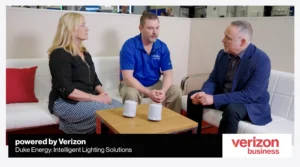DTECH 2024: Predictive Weather Analytics is One Way ELM Seeks to Improve Rural Electrification
Rural electrification is at a crossroads, facing challenges such as outdated infrastructure, high energy costs, and the rapid adoption of electric vehicles (EVs). These issues multiply in rural areas, where the transition to sustainable energy sources is not just a matter of environmental responsibility but also economic and social necessity. Introducing government incentives like those in the Inflation Reduction Act offers hope, promising to alleviate some financial burdens and accelerate the shift towards renewable energy. This shift is crucial for enhancing energy efficiency, reducing carbon emissions, and ensuring the resilience and sustainability of rural communities amid growing demands.
As the industry explores solutions to these pressing challenges, MarketScale spoke with Aron Bowman, the President of ELM Microgrid and ELM Solar, at DISTRIBUTECH 2024. Bowman’s work focuses on innovative energy solutions, such as mid-size microgrid systems, that promise to optimize energy usage and enhance grid reliability in rural areas. His insights into deploying predictive weather analytics and microgrid systems underscore the importance of tailored, strategic approaches to rural electrification.
Aron’s Thoughts
“Everyone focuses on these challenges with the grid, and a lot of the attention gets paid to the large cities and the large challenges, especially with the electrification of vehicles. But we work a lot with co-ops around the country, from the Tennessee Valley to the Midwest markets and into Texas, where we’re located with our factory. They’re facing a lot of the same challenges but in a slightly different way because they don’t have a lot of industrial-grade areas that they can pull on. They have communities that have built up in what was a rural farm area, and now you’ve got a couple hundred homes. And now, when you start talking about those couple hundred homes, going to electric vehicles and the additional loads that homes are doing with more air conditioning and larger homes, they’re really getting stressed and trying to figure out how to handle balancing infrastructure growth with the limited resources and funds they sometimes have.
A lot of them, what we’re working with is being able to drop mid-size systems. So, one-megawatt and two-megawatt size systems are right into the substations so that we can optimize charging power overnight when the usage is low and have them up time for usage when demand is high, but then also be able to work. We’re working with them to start developing predictive weather analytics so that they can see that instead of using it for time-of-use shifting, maybe we’re going to save up the battery to respond to a storm event that’s going to come. It really does help a lot because, normally, downtime is north of the substation in regard to what the substation is serving. We can bring that power right into the substation and really help them with response times and allow them to be more systematic with how they deploy their resources to solve problems in a major storm or down event.
First, we spend a lot of time just talking upfront. We don’t come right in and try to plug in what we have and say, here’s the system and solution for you. We spend a lot of time working with them and discussing things we’ve seen. We’ve worked with utilities across the country, from California to New York, from Florida to Michigan and Minnesota. And so we’ve seen a lot of different applications. We also do a lot of things in the islands, like Puerto Rico and Hawaii. We’ve seen a lot of various challenges that these smaller utilities face. And we’re also always interested in learning more about what we could potentially do to help them. So, really, the first thing is just starting with a conversation and understanding their challenges. And then we’re happy to look at some design options free of charge to kind of help them figure out where they think they can go. And if we can figure out a more systematic approach that’ll help them solve their problems.”
Article by James Kent









